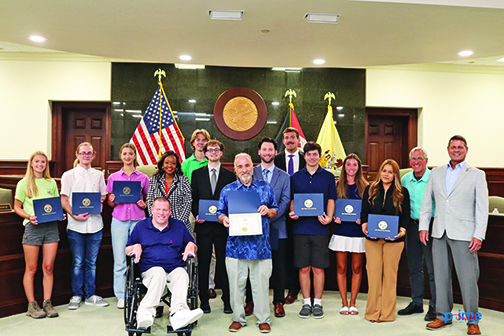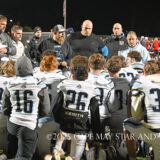CAPE MAY COURT HOUSE — For family activities, horseshoe crab tagging has to rank among the more unusual. But for the environmentally conscious, there are multiple reasons to enjoy it.
For the Van Wingerden family of Ocean City — Kevin and Rhonda and daughters Lily and Hannah — it has become an annual ritual.
The tagging this year at Kimbles Beach was the third time they’ve taken part. They explained what brings them back each year.
“It’s a good chance to be with one of my favorite animals, to help them, and to have fun,” Hannah, 14, said.
“It’s a chance to give our local scientists a hand, in what would otherwise be a very time-consuming task, but many volunteers make it go quickly,” Lily, 19, said. “It’s amazing to be involved in something like that, and it’s an opportunity to participate in meaningful science without needing a Ph.D.”
“One thing that I love about horseshoe crab tagging is that it’s so different from anything else that the average person does on a day-to-day basis,” Rhonda said. “Most volunteer activities that we’re familiar with, such as donating food, participating in a beach cleanup or planting a pollinator garden, all happen during the day in relatively familiar environments. Horseshoe crab tagging takes you out of the norm and puts you into this totally different place and time.
“When else do you get to wander around the bay at night, with a bunch of strangers wearing headlamps that project only red light, looking for creatures that have been around since before the time of dinosaurs? It’s like nothing else, and it’s such a good reminder that there’s a whole world out there that’s totally different from our everyday routines,” Rhonda said. “The whole experience, including looking up and down the beach and seeing specs of red light moving up and down the beach, is inspiring. You can’t help but recognize that there are so many people who really care and want to help.”
The Van Wingerdens were among some 75 volunteers June 10 as the sun set over Delaware Bay to support the U.S. Fish and Wildlife Service biologists from the Cape May National Wildlife Refuge.
The volunteers broke into groups of four to five people armed with a clipboard for taking information, a bag of tags, a drill to put a small hole in the crabs’ shells and a small container of alcohol to clean the drill bit after each use.
“It’s a great event because there’s a role for everyone,” Lily said. “If you’re hesitant about handling horseshoe crabs, you can hold the clipboard and data sheet while recording tag numbers. But you can also wade into the shallows, where all of the crabs are scooting about, and pick them up for tagging.
“When you look at the underside of a horseshoe crab, you see all these legs waving about like crazy,” she added. “Combined with their telsons (their long tails), the crabs can look scary and alien-like. Don’t be alarmed!
“The crabs are much more harmless than their appearance suggests. You can just hold them by the sides of their shell, they’re not going to bite or sting or anything. One of their legs might accidentally bump into your hand, but that’s about it. It’s really fun to be able to hold these unique animals, which you don’t get many chances to do with most wildlife,” Lily said. “Both Hannah and I love holding them!”
“One of the things that I really enjoy about horseshoe crab tagging is seeing the wide variety of people who participate,” Rhonda said. “There are older people, young budding biologists and parents with toddlers in tow. Here you are with all of these different people working toward a common goal. You get to meet new people, contribute toward science, and it’s a lot of fun!”
“The largest population of horseshoe crabs is in the Delaware Bay,” Lily said. “We’re so lucky that we can see them come ashore to lay their eggs each year. It’s amazing that this unique event takes place not only in New Jersey, but specifically in Cape May County, and that we can witness it simply by driving a half-hour from Ocean City. Tagging is a perfect opportunity to see the horseshoe crabs spawning and to help such an old, old species continue to survive.”
“It’s eye-opening to understand that shorebirds, like the red knots, can’t complete their migration to the Arctic if they don’t eat enough horseshoe crab eggs at these stop-overs,” Rhonda said. “When that connection is made, it’s easy to want to help keep horseshoe crab populations healthy. How lucky we are that these stopovers happen right here in Cape May County?”
“It’s exciting to be part of such an incredible natural event,” Hannah said, “and I’m already looking forward to next year.”
By DAVID NAHAN/Cape May Star and Wave




